Geography
Phitsanulok province covers some 10,584.5 sq. km. The riverside provincial capital is 377 km. North of Bangkok. Phitsanulok is situated on the geographical and administrative line uniting the central and northern regions. Phitsanuloke, located in Central Northern Thailand is a modern city. Ideal as a stepping stone for the Northern visitors attractions including Sukothai.
Phitsanulok was the birthplace of King Naresuan the Great of Ayuthaya (reign : 1590 - 1605), and his brother Prince Ekathosarot. Phitsanulok has long been an important center for political and strategic reasons. Phitsanulok was a major center of recruitment when Ayuthaya waged war with Burma, and was the capital of Thailand for 25 years during the 1448-1488 reign of Ayuthaya’s King Boromtrailokanat.
The climate of Phitsanulok is generally hot and humid. It borders with Uttaradit in he North, Pichit in the south, Loei and Phetchabun in the East, Kamphaeng Phet and Sukhothai in the West. Covering an area of 10,815.8 sq.km., the province is divided into 9 Amphoes : Muang , Bang Rakam , Nakhon Thai , Phrom Priram , Wat Bot - BangKrathum , Chat Trakan , Noen MaPrang , Wang Thong
City Attraction
Wat Phra Si Rattana Mahathat his monastery commonly called by the inhabitants as "Wat Yai" is the most important monastery of Phitsanulok, the home of the famous Phra Buddha Chinnarat. It is located at the foot of Naresuan Bridge on the city side of the river.The monastery was built in the reign of Phra Maha Thamma Racha I (Phraya Lithai) In 1357 A.D. It houses the Phra Buddha Chinnarat regarded as the most beautiful Buddha image in Thailand. It is cast in the attitude of subduing evil. Later, in 1631, King Ekatosarot graciously bestowed some of his gold regalia to be beaten into gold - plate and applied them to the image worth his own hands, creating its most beautiful Buddha image. There are many other beautiful and noteworthy items in the monastery compound. The mother - of - pearl inlaid wooden doors of Vihara are especially splendid, and were built by King Boromkot in 1756 as a dedication to phra Buddha Chinarat. Behind the Vihara, there is a large Prang 36 meters high, with a staircase leading up to the niche containing the Buddha relics. In front of the Prang, there is Phra Attharos, and on the 9 room Vihara slope. There remains only the newly-renovated Buddha image.
Wat Ratchaburana nad Wat Nang Phya Is located on the eastern bank of the Nan river, near Wat Phra Si Rattana Mahathat to the south. These two monasteries, assumed to be built when Phitsanulok City was ruled by King Boromtrailokanat, have linking compounds. Wat Nang Phya has temple or bot but it is known for the so-called "Phra Nang Phya" votive tablets special fine form of the 3-head nagas decorated on their eaves.
King Naresuan the Great Shrine The shrine is located in the compound of the Phitsanulok Phittayakom school, and depicts the seated king ceremoniously declaring Ayuthaya's independence from Burma. The shrine was constructed on the site of the Channdra Palace where King Naresuan was born in 1555.
Biography King Naresuan the Great
 Phitsanulok was the birthplace of one of the greatest heroes in Thai history - King Naresuan who was born in 1555. His father, King Mahathammaracha was a descendant of the Phra Ruang dynasty of Sukhothai, and his mother was Queen Phra Wisut Kasattri of the Suwannaphum dynasty of Ayutthaya. At the age of nine, he had been taken as hostage to Burma for 6 years. King Naresuan was a great warrior king. He liberated Ayutthaya from Burma while he was the Crown Prince. He led the soldiers into battles to defend the country against Burmese invasions many times. He is also widely known among the Thais nowadays for his heroic efforts. He led the assault of a Burmese camp by climbing the wooden stockade with the blunt side of a saber in his mouth. He had a duel on elephants with the Burmese Crown Prince and slew him. He took the offensive against Burma and also dealt with the Cambodians who made a series of raids. King Naresuan extended Ayutthaya's territory to include Lanna, Lanchang, Cambodia and some parts of Burma. He enforced strict discipline on his soldiers and the people. During his reign, Ayutthaya was a very secure and powerful state.
Phitsanulok was the birthplace of one of the greatest heroes in Thai history - King Naresuan who was born in 1555. His father, King Mahathammaracha was a descendant of the Phra Ruang dynasty of Sukhothai, and his mother was Queen Phra Wisut Kasattri of the Suwannaphum dynasty of Ayutthaya. At the age of nine, he had been taken as hostage to Burma for 6 years. King Naresuan was a great warrior king. He liberated Ayutthaya from Burma while he was the Crown Prince. He led the soldiers into battles to defend the country against Burmese invasions many times. He is also widely known among the Thais nowadays for his heroic efforts. He led the assault of a Burmese camp by climbing the wooden stockade with the blunt side of a saber in his mouth. He had a duel on elephants with the Burmese Crown Prince and slew him. He took the offensive against Burma and also dealt with the Cambodians who made a series of raids. King Naresuan extended Ayutthaya's territory to include Lanna, Lanchang, Cambodia and some parts of Burma. He enforced strict discipline on his soldiers and the people. During his reign, Ayutthaya was a very secure and powerful state.Apart from being a great warrior, King Naresuan also played a significant role in foreign relations and trade. Realizing the importance of foreign trade, he sent envoys to China and Spain, and cultivated friendly relations with the Europeans. Ayutthaya concluded a treaty of friendship and commerce with Spain, which was the second treaty that Siam made with a European Power. (The first European power with which Siam had a treaty was Portugal.) Under this treaty, Spaniards had the right to reside, to trade and to practice their religion in Siam. At the end of his reign, he exposed Ayutthaya to another western nation - the Dutch.
King Naresuan deserved the honor of being "the Great". He not only restored the national independence but also made Siam such a powerful country that no enemy threatened the walls of Ayutthaya again for a period of one hundred seventy three years. Three of King Naresuan's weapons and belongings have constituted a part of the Royal Regalia down to the present. The first is the musket with which he shot the Burmese leader in one of the battles to defend Ayutthaya against Burma. Second is the saber that he carried in his mouth during his assault on the Burmese camp at Ayutthaya. The last is the leather hat with a brim cut-off in the shape of a crescent moon, which he was wearing when he engaged in a duel on elephants with the Crown Prince of Burma.
For more information : http://www.kingnaresuanmovie.com/
 Phitsanulok was the birthplace of one of the greatest heroes in Thai history - King Naresuan who was born in 1555. His father, King Mahathammaracha was a descendant of the Phra Ruang dynasty of Sukhothai, and his mother was Queen Phra Wisut Kasattri of the Suwannaphum dynasty of Ayutthaya. At the age of nine, he had been taken as hostage to Burma for 6 years. King Naresuan was a great warrior king. He liberated Ayutthaya from Burma while he was the Crown Prince. He led the soldiers into battles to defend the country against Burmese invasions many times. He is also widely known among the Thais nowadays for his heroic efforts. He led the assault of a Burmese camp by climbing the wooden stockade with the blunt side of a saber in his mouth. He had a duel on elephants with the Burmese Crown Prince and slew him. He took the offensive against Burma and also dealt with the Cambodians who made a series of raids. King Naresuan extended Ayutthaya's territory to include Lanna, Lanchang, Cambodia and some parts of Burma. He enforced strict discipline on his soldiers and the people. During his reign, Ayutthaya was a very secure and powerful state.
Phitsanulok was the birthplace of one of the greatest heroes in Thai history - King Naresuan who was born in 1555. His father, King Mahathammaracha was a descendant of the Phra Ruang dynasty of Sukhothai, and his mother was Queen Phra Wisut Kasattri of the Suwannaphum dynasty of Ayutthaya. At the age of nine, he had been taken as hostage to Burma for 6 years. King Naresuan was a great warrior king. He liberated Ayutthaya from Burma while he was the Crown Prince. He led the soldiers into battles to defend the country against Burmese invasions many times. He is also widely known among the Thais nowadays for his heroic efforts. He led the assault of a Burmese camp by climbing the wooden stockade with the blunt side of a saber in his mouth. He had a duel on elephants with the Burmese Crown Prince and slew him. He took the offensive against Burma and also dealt with the Cambodians who made a series of raids. King Naresuan extended Ayutthaya's territory to include Lanna, Lanchang, Cambodia and some parts of Burma. He enforced strict discipline on his soldiers and the people. During his reign, Ayutthaya was a very secure and powerful state.



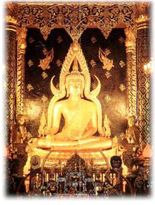
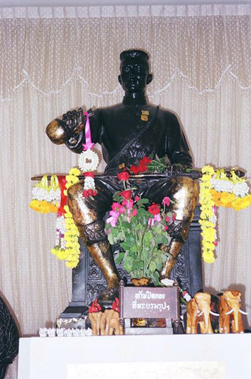
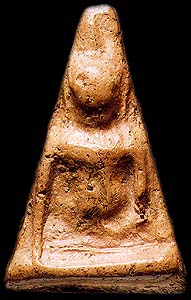
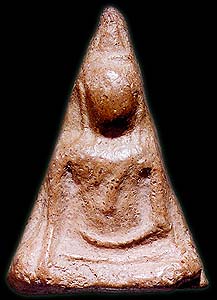
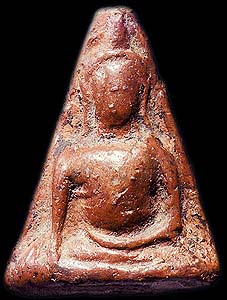
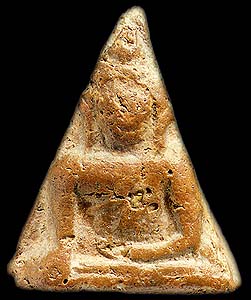
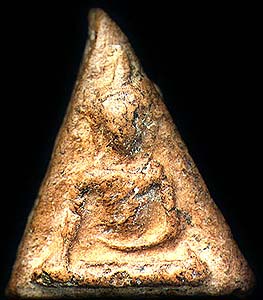
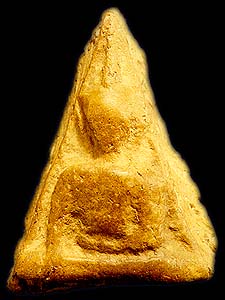
No comments:
Post a Comment